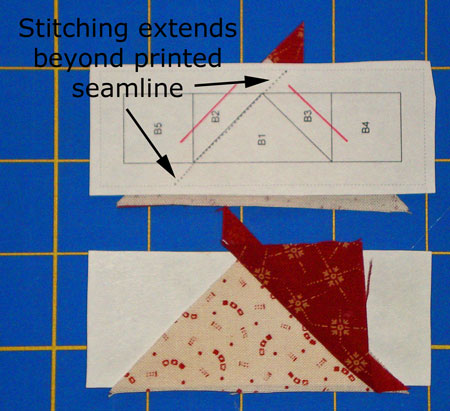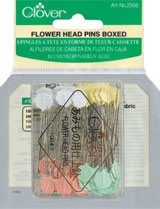- Home
- Paper Piecing
- Foundation Paper Piecing
Foundation Paper Piecing Instructions
Lesson 1: Stitching Sections
This post contains affiliate links, for which I receive compensation.
 Our Sawtooth Star project
Our Sawtooth Star projectOur first foundation paper piecing lesson begins.
We start with how to prepare our pattern.
Then it's time to stitch each individual section of our Sawtooth Star.
Prepare the foundation pattern
Follow these simple steps to get ready for stitching.
Step 1
Cut apart the foundation piecing pattern into its four sections (A, B, C and D). This is a rough cut and doesn't need to be exact.
Step 2
Mark the placement lines for the first piece. Place the quarter inch mark of your ruler on the solid line between pieces A1 and A2.
With a pencil, lightly mark 1/4" away from the solid line on the A2 side.
I used a red pen here to make it easier for you to see. I would not use it on something for myself because I wouldn't want it to accidentally bleed onto the fabric.
Repeat for the A3 side. Repeat for B, C, and D.
There is no need to mark the bottom side.
NOTE: Since I first wrote this tutorial, I've been adding dashed guidelines to all the paper piecing patterns in the Free Library. Eventually I'll get this pattern updated, as well as include a few more sizes. :)
 Because it's easier for you to see, I've marked the foundation piecing placement lines in red pen. For your block please use a pencil with a light touch, no pen.
Because it's easier for you to see, I've marked the foundation piecing placement lines in red pen. For your block please use a pencil with a light touch, no pen.Piecing each section
A, B, C, and D all have the same Piece 1.
Step 1
Starting with Piece 1, place one of the light triangles, wrong side to the unprinted side of the foundation paper, aligning the bias edges with the drawn placement lines. You may need to hold the paper up to the light to see this.
Pin in place or use the tiniest dab of Elmer's Washable Glue Stick to hold it in place.
NOTE: The triangles are cut so that the straight of grain is on the outside edge. This makes the final quilt block more stable

Step 2
With right sides together (RST), align the bias edge of a dark (the red fabric in this example) triangle with the light triangle on the A2 side.

Stitch on the printed side of the foundation paper.
Remember to begin a few stitches before the printed line starts and end a few stitches after it ends.
In foundation paper piecing, subsequent seams cross these sewn seams and lock them in place.
As long as you sew your seams this way, there is no need to back stitch.
 Sew the seam beginning before and ending after the printed line
Sew the seam beginning before and ending after the printed linePress the dark triangle open with a dry iron set to a cotton setting. Using steam tends to curl the paper, making it harder to work with. (Not impossible, just a bit harder. Knowledge is power!)
Repeat this step for Piece A3. Repeat Steps 1-2 for Sections B, C, and D.
Step 3
Section D is now completed. It looks a bit messy, doesn't it?
Set it aside for now, we will trim it later. It'll be perfect!
 Completed Section D, untrimmed
Completed Section D, untrimmedOur foundation paper piecing lesson continues...
Step 4: Complete Sections B & C
Establish the seam allowance for Piece #4. We use our ruler to help us make a nice straight fold.
Place the edge of your ruler on the solid black line between #3 and #4. (In this picture we are working on Section C so place the ruler between C3 and C4).
Crease the paper with your thumbnail at the edge of the ruler on the black line.
Remove the ruler and fold the paper pattern back on the solid black line. You will need to gently pull the paper away from some of your stitching to do this.
If your paper tears, you can repair it with Scotch Brand Magic™ Tape.

NOTE: If you look closely at this picture, you'll see that the paper has been torn from the seam under the notation 'C4' (down and to the left just a bit).
This tear allows us to fold the paper back easily as seen in the next picture.
Step 5
Position the quarter inch mark of your ruler along this fold.
Trim with a rotary cutter and ruler. This leaves a quarter inch seam allowance and creates the placement line for the next piece.
 Trim to a quarter inch seam allowance. In the lower right corner, you can see where the paper has been torn along the stitching.
Trim to a quarter inch seam allowance. In the lower right corner, you can see where the paper has been torn along the stitching.Step 6
For Sections B and C, align one light background 1-3/4" square, RST, with this cut edge, centering it in the space. Pin or hold in place.

From the paper side, stitch along the solid black line between Piece #3 and #4. Repeat for Pieces B5 and C5. Press.
Our foundation paper piecing lesson continues as we...
Step 7: Complete Section A
Establish the seam allowance for piece #4 just like we did for Sections B and C.
You will need to pull the paper foundation away from some of the stitching to do this. Be gentle. It doesn't hurt to rip the foundation a bit, just don't rip the pieces apart.

Place the edge of your ruler on the solid black line between Piece #4 and Pieces #1-3. Fold the paper pattern over the ruler and crease along the solid black line.
Step 8
Just like before, position the quarter inch line of the ruler along this fold and trim with a rotary cutter and ruler. This leaves a quarter inch seam allowance.
Step 9
Align the dark 2-1/2" square, RST, with this cut edge, centering it in the space. Pin or hold in place.

From the paper side, stitch along the solid black line between Piece #4 and Pieces #1-3, starting and stopping your stitching well into the seam allowance. Press Piece #4 open.
This completes our first foundation paper piecing lesson. It's time to move on to join our foundation paper piecing sections together by clicking the 'Go to Lesson 2: Joining Sections' link below.













